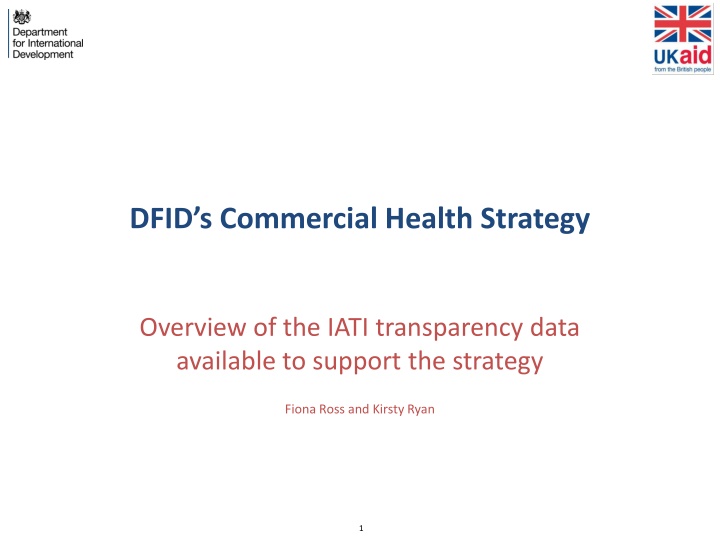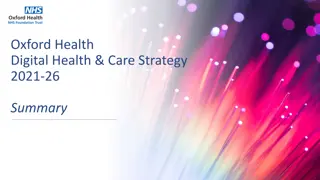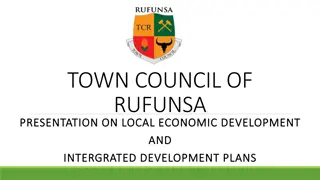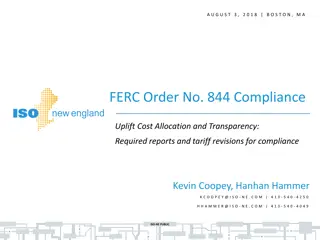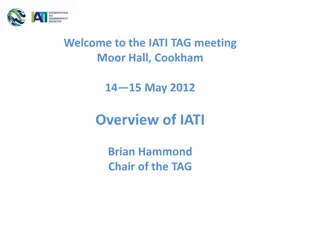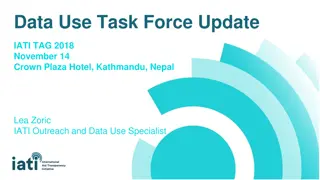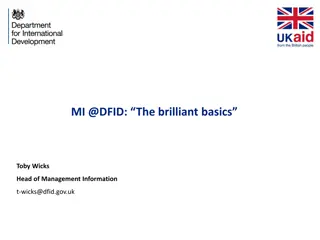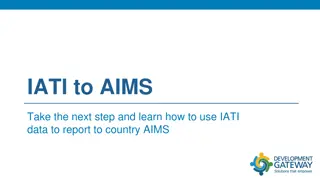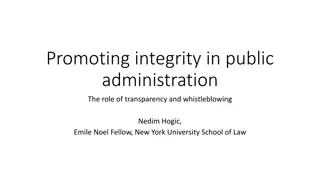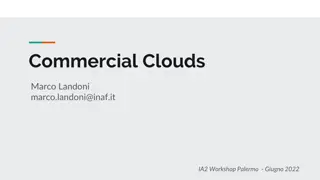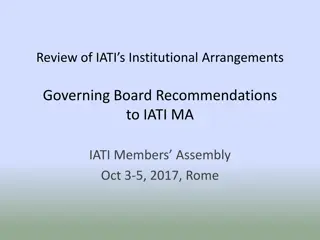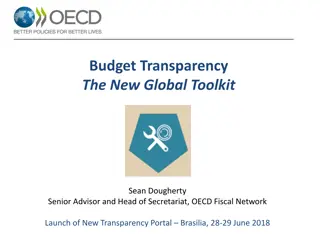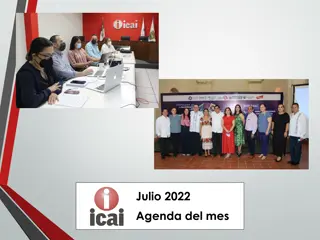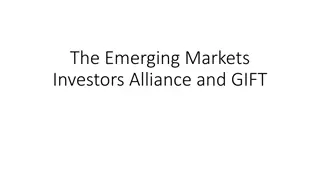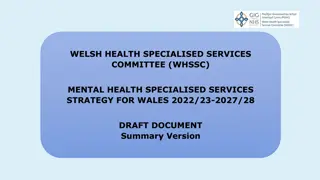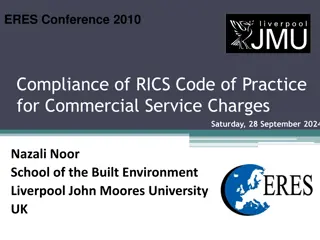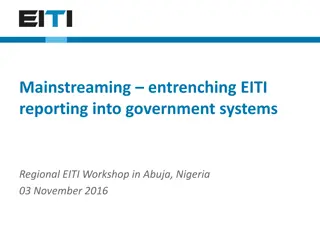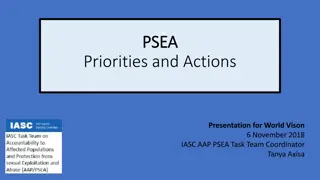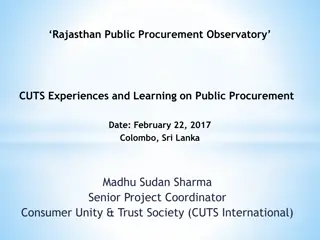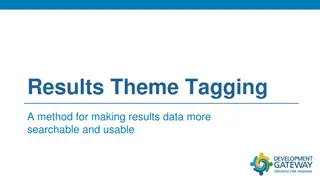Enhancing Transparency in DFID's Commercial Health Strategy with IATI Data
DFID's Commercial Health Strategy aims to improve value for money and commercial understanding of health spending by utilizing data from various sources. Transparency is crucial for tracking ODA spend and identifying areas for improvement in supply chains and coordination efforts. The goal is to establish a global standard for transparency through tools like IATI, enabling better traceability of funds and fostering accountability in the development community.
Download Presentation

Please find below an Image/Link to download the presentation.
The content on the website is provided AS IS for your information and personal use only. It may not be sold, licensed, or shared on other websites without obtaining consent from the author.If you encounter any issues during the download, it is possible that the publisher has removed the file from their server.
You are allowed to download the files provided on this website for personal or commercial use, subject to the condition that they are used lawfully. All files are the property of their respective owners.
The content on the website is provided AS IS for your information and personal use only. It may not be sold, licensed, or shared on other websites without obtaining consent from the author.
E N D
Presentation Transcript
DFIDs Commercial Health Strategy Overview of the IATI transparency data available to support the strategy Fiona Ross and Kirsty Ryan 1
What did we want to do with the data? DFID spends approximately 2bn (~20%) of its annual budget on health programmes representing approximately 20% of all DAC donor spend. This spend includes both technical assistance and commodity spend and is channelled through a range of partners governments, multilaterals, NGOs and private sector, operating in a complex web of global and local supply chains, and using multiple funding models. Whilst DFID works hard to co-ordinate this activity it is difficult for initiatives to be joined up in such a complex global context; do the many good initiatives we have work together as a whole, and does DFID have a strategic and commercial view of its health spending plans going forwards? The Commercial Health Strategy aims to begin answering questions like these, driving value for money improvements and enhancing commercial understanding of all DFID health spend. An important tool for us during the strategy was data from both internal and external sources. It was crucial for us to have a high level oversight of all aid spend to then be able to drill down into this to understand how supply chains are operating in different areas and where efforts could be better joined up. From the outset, accessibility of data was an issue and we had to obtain figures from various sources which often gave conflicting information. There needs to be one global standard for transparency which allows the development community to clearly trace all ODA spend from donor to end beneficiary and user friendly tools that allow everyone to access and fully utilise this data. IATI has the potential to do exactly this, but there is a lot more work to be done on global compliance, the meaningfulness of the current data and the availability of tools to begin analysing and using this data. 2
Why transparency? The development community, particularly donors, want to be able to understand where their money has gone. This is important for a number of reasons: 1. Effectiveness and impact: knowing which projects and programmes have been the most effective and understanding where value for money improvements and global savings can be made; 2. Understanding and communication: being able to see more information about the projects funded and their supply chains, understanding who the major actors are and where market development/diversification needs to happen. To present information on projects and their impacts to the public to build support for development; 3. Addressing fraud and corruption: identifying leakage and misuse of funds to give greater value for money of all ODA spend and understand where to target efforts. Why do we need traceability? Traceability is important because the relationship between donor and delivery is often indirect. A grant may pass through a number of intermediary organisations before it reaches the ultimate beneficiaries. In order to effect change in the system we need to understand the agreements that are currently in place between different actors and also have a clear picture of which partners major donors are working with in their supply chains. 3
We want to see how ODA flows through the international development community Example: Funding flows in Burma: just one fund in one country 3MDG is a pooled donor fund operating in Burma. With commitments totalling more than $271 million from Jul 2012 to Dec 2017, it is currently the largest development fund in Burma. This visual was derived from 3MDG s website. They have a list of recent grants and tenders and who they were awarded to but does not quantify funding. Understanding community health experiences Improvement of midwifery MNCH: various regions Development of local NGO partners TB Commodity tracking system review Malaria programmes HIV Creating a picture like this currently takes considerable background knowledge and time spent researching. We also cannot get figures to put on this diagram so its use is limited in helping us to understand the supply chains. programmes programmes United General Inspection Co. Ltd. Arr Yone Oo Social Development Association Myanmar MoH Community driven development and capacity enhancement team Charity Oriented Myanmar This data and analysis showing each tier of the supply chain including values, should be available via IATI toolsets the data architecture already exists in IATI to make this a possibility! Phan Tee Eain In partnership with 19 Community Based Organizations (CBOs) Data source: http://www.3mdg.org/grants-and-tenders/grants 4
Limitations of IATI Limitations of the tools Limitations of the data Incomplete global dataset Not all donors/organisations are inputting their data into the IATI registry and the level of completeness of the data is unknown. There is no summary report of available of all IATI data that we are aware of. Ability to query and filter the data Some tools to access IATI datasets can only query one dimension at a time, for example you can see data by country OR sector but not both at the same time. Ability to show traceability of the supply chain Whilst the top level of data is visible, it is difficult to drill down to learn more about the downstream suppliers each donor/organisation is using. Existing IATI platforms do not show hierarchy/tiers of data, leading to confusion about what the data is showing. Lack of linkage between activities Although mechanisms exist to create linkages between organisations that are funding activities and organisations that are implementing activities, few reporting organisations are utilising these fields. This can lead to double counting . 5
What changes do we want to see as a priority? Collectively encourage the whole donor community, including non-DAC donors, to publish meaningful and complete data to IATI this is just the starting point! Encourage donors to consistently push from the top down to ensure all partners they are working with throughout their supply chains are also publishing. Improved compliance The architecture of IATI fields allow activities to be related, reporting organisations can fill in fields to state where the money for the activity came from and which other organisations are participating in the chain traceability is possible! The donor community should guide their partners in utilising these fields to their full potential. Greater traceability Current tools are great for general public use but if IATI data is to be used by the development community to improve aid impact and achieve greater value for money the tools need to be more sophisticated and developed. When we have greater compliance and more complete related data, the tools need to be able to capitalise on this architecture to create visuals of funding flows through actors to end beneficiaries and the relationships this money passes through. Development of new tools and platforms 6
